International Hospitality: Marriott's Market Entry Strategy Report
VerifiedAdded on 2024/05/16
|20
|5578
|61
Report
AI Summary
This report provides a comprehensive analysis of the international hotel industry, focusing on Marriott Hotel's expansion strategies in emerging markets. It begins with a background of the international hotel and tourism industry, followed by a SWOT analysis of Marriott West India Quay Hotel, identifying its strengths, weaknesses, opportunities, and threats. The report then examines the global hotel and tourism industry, contrasting developed and emerging markets, with a specific focus on India as a potential emerging market. A PEST analysis of India is conducted to assess the political, economic, social, and technological factors influencing the hotel industry. Based on these analyses, the report proposes a hotel strategy for Marriott to adopt and implement in the Indian market, utilizing strategic models and frameworks such as Nykiel's fourteen hotel strategic growth options. The justification for the chosen strategy is provided, along with a practical application of the strategy projected 5 and 10 years into the future. The report concludes with a summary of the findings and recommendations for Marriott's successful market entry and growth in the competitive global hotel industry.
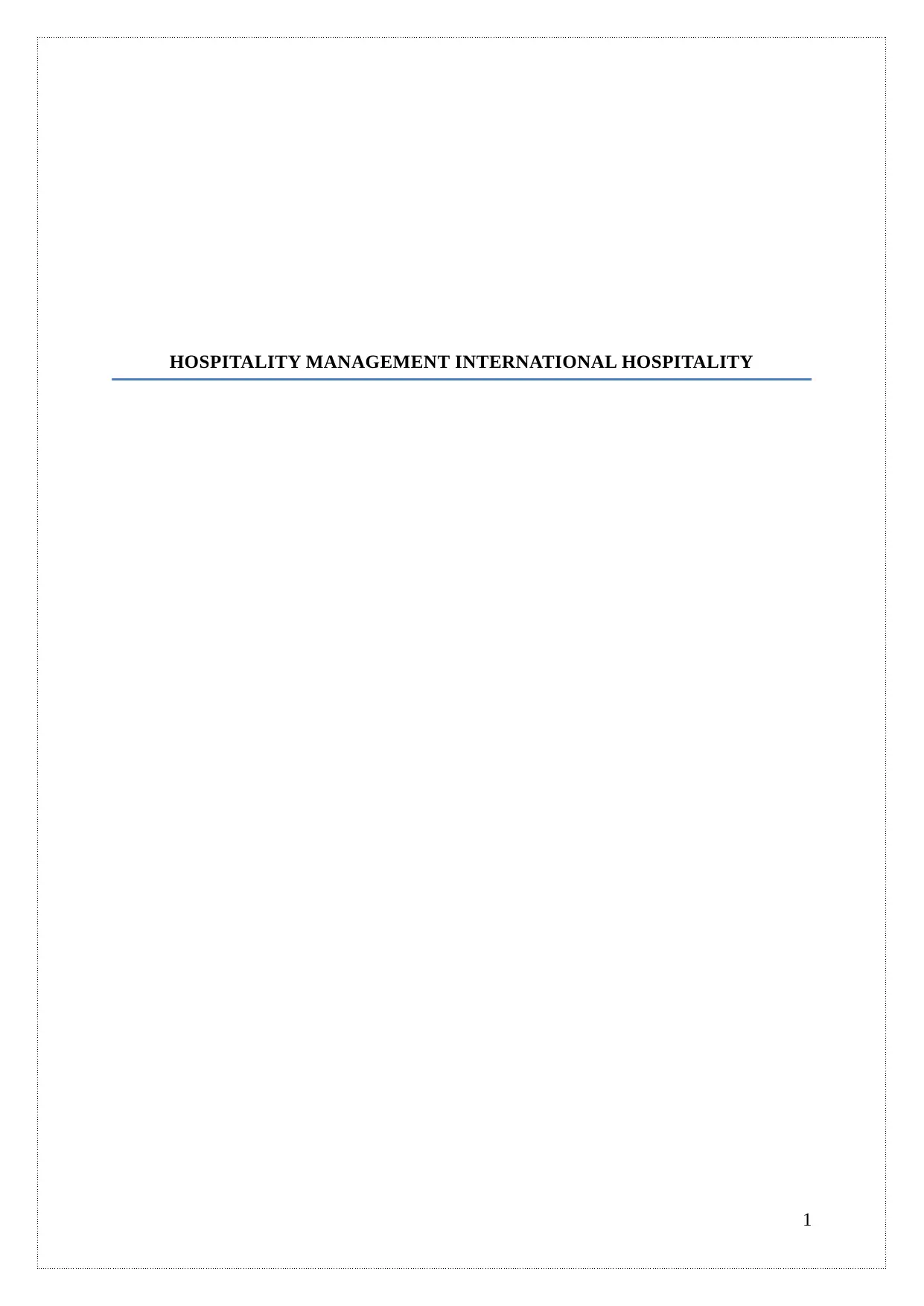
HOSPITALITY MANAGEMENT INTERNATIONAL HOSPITALITY
1
1
Paraphrase This Document
Need a fresh take? Get an instant paraphrase of this document with our AI Paraphraser
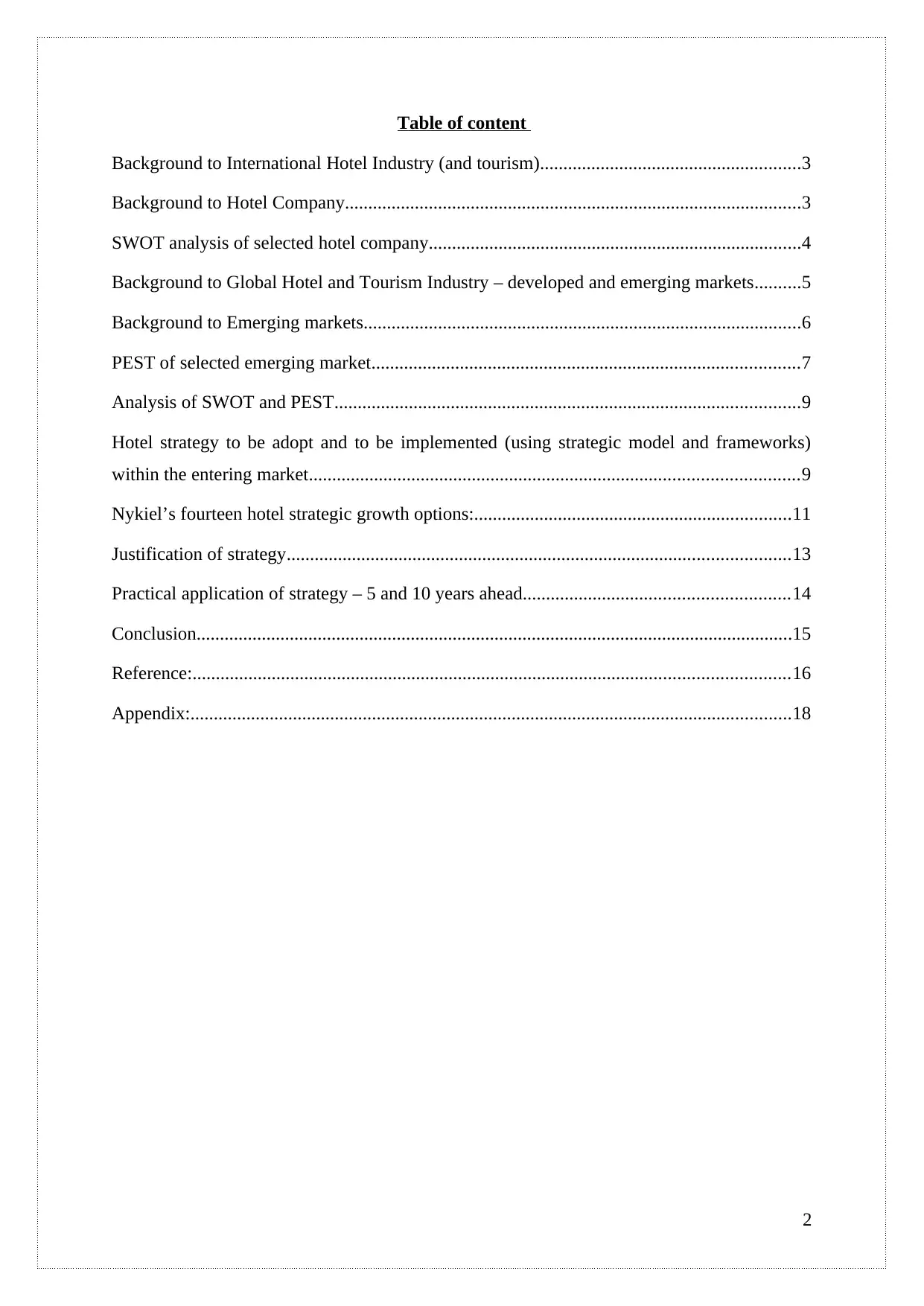
Table of content
Background to International Hotel Industry (and tourism)........................................................3
Background to Hotel Company..................................................................................................3
SWOT analysis of selected hotel company................................................................................4
Background to Global Hotel and Tourism Industry – developed and emerging markets..........5
Background to Emerging markets..............................................................................................6
PEST of selected emerging market............................................................................................7
Analysis of SWOT and PEST....................................................................................................9
Hotel strategy to be adopt and to be implemented (using strategic model and frameworks)
within the entering market.........................................................................................................9
Nykiel’s fourteen hotel strategic growth options:....................................................................11
Justification of strategy............................................................................................................13
Practical application of strategy – 5 and 10 years ahead.........................................................14
Conclusion................................................................................................................................15
Reference:................................................................................................................................16
Appendix:.................................................................................................................................18
2
Background to International Hotel Industry (and tourism)........................................................3
Background to Hotel Company..................................................................................................3
SWOT analysis of selected hotel company................................................................................4
Background to Global Hotel and Tourism Industry – developed and emerging markets..........5
Background to Emerging markets..............................................................................................6
PEST of selected emerging market............................................................................................7
Analysis of SWOT and PEST....................................................................................................9
Hotel strategy to be adopt and to be implemented (using strategic model and frameworks)
within the entering market.........................................................................................................9
Nykiel’s fourteen hotel strategic growth options:....................................................................11
Justification of strategy............................................................................................................13
Practical application of strategy – 5 and 10 years ahead.........................................................14
Conclusion................................................................................................................................15
Reference:................................................................................................................................16
Appendix:.................................................................................................................................18
2
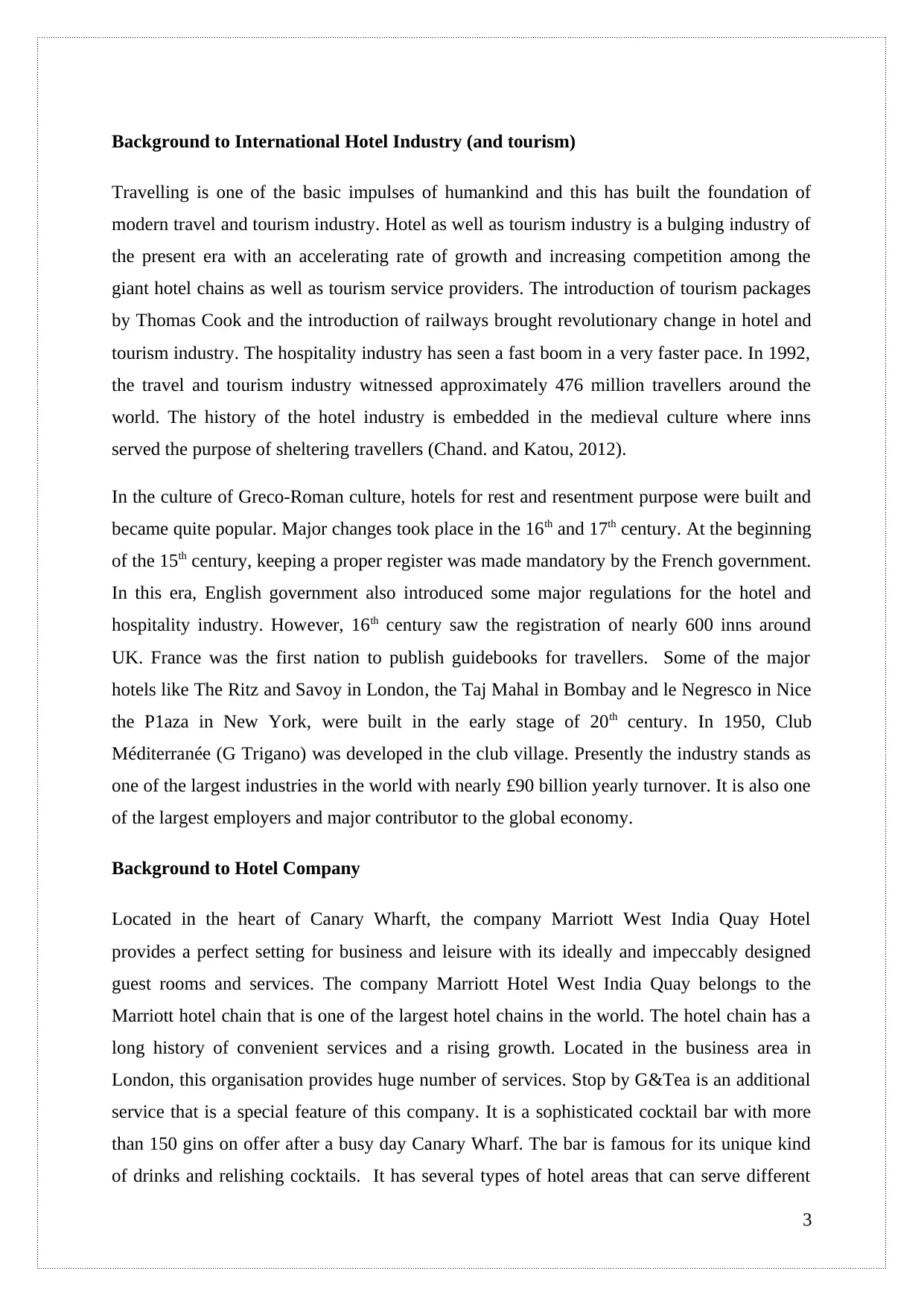
Background to International Hotel Industry (and tourism)
Travelling is one of the basic impulses of humankind and this has built the foundation of
modern travel and tourism industry. Hotel as well as tourism industry is a bulging industry of
the present era with an accelerating rate of growth and increasing competition among the
giant hotel chains as well as tourism service providers. The introduction of tourism packages
by Thomas Cook and the introduction of railways brought revolutionary change in hotel and
tourism industry. The hospitality industry has seen a fast boom in a very faster pace. In 1992,
the travel and tourism industry witnessed approximately 476 million travellers around the
world. The history of the hotel industry is embedded in the medieval culture where inns
served the purpose of sheltering travellers (Chand. and Katou, 2012).
In the culture of Greco-Roman culture, hotels for rest and resentment purpose were built and
became quite popular. Major changes took place in the 16th and 17th century. At the beginning
of the 15th century, keeping a proper register was made mandatory by the French government.
In this era, English government also introduced some major regulations for the hotel and
hospitality industry. However, 16th century saw the registration of nearly 600 inns around
UK. France was the first nation to publish guidebooks for travellers. Some of the major
hotels like The Ritz and Savoy in London, the Taj Mahal in Bombay and le Negresco in Nice
the P1aza in New York, were built in the early stage of 20th century. In 1950, Club
Méditerranée (G Trigano) was developed in the club village. Presently the industry stands as
one of the largest industries in the world with nearly £90 billion yearly turnover. It is also one
of the largest employers and major contributor to the global economy.
Background to Hotel Company
Located in the heart of Canary Wharft, the company Marriott West India Quay Hotel
provides a perfect setting for business and leisure with its ideally and impeccably designed
guest rooms and services. The company Marriott Hotel West India Quay belongs to the
Marriott hotel chain that is one of the largest hotel chains in the world. The hotel chain has a
long history of convenient services and a rising growth. Located in the business area in
London, this organisation provides huge number of services. Stop by G&Tea is an additional
service that is a special feature of this company. It is a sophisticated cocktail bar with more
than 150 gins on offer after a busy day Canary Wharf. The bar is famous for its unique kind
of drinks and relishing cocktails. It has several types of hotel areas that can serve different
3
Travelling is one of the basic impulses of humankind and this has built the foundation of
modern travel and tourism industry. Hotel as well as tourism industry is a bulging industry of
the present era with an accelerating rate of growth and increasing competition among the
giant hotel chains as well as tourism service providers. The introduction of tourism packages
by Thomas Cook and the introduction of railways brought revolutionary change in hotel and
tourism industry. The hospitality industry has seen a fast boom in a very faster pace. In 1992,
the travel and tourism industry witnessed approximately 476 million travellers around the
world. The history of the hotel industry is embedded in the medieval culture where inns
served the purpose of sheltering travellers (Chand. and Katou, 2012).
In the culture of Greco-Roman culture, hotels for rest and resentment purpose were built and
became quite popular. Major changes took place in the 16th and 17th century. At the beginning
of the 15th century, keeping a proper register was made mandatory by the French government.
In this era, English government also introduced some major regulations for the hotel and
hospitality industry. However, 16th century saw the registration of nearly 600 inns around
UK. France was the first nation to publish guidebooks for travellers. Some of the major
hotels like The Ritz and Savoy in London, the Taj Mahal in Bombay and le Negresco in Nice
the P1aza in New York, were built in the early stage of 20th century. In 1950, Club
Méditerranée (G Trigano) was developed in the club village. Presently the industry stands as
one of the largest industries in the world with nearly £90 billion yearly turnover. It is also one
of the largest employers and major contributor to the global economy.
Background to Hotel Company
Located in the heart of Canary Wharft, the company Marriott West India Quay Hotel
provides a perfect setting for business and leisure with its ideally and impeccably designed
guest rooms and services. The company Marriott Hotel West India Quay belongs to the
Marriott hotel chain that is one of the largest hotel chains in the world. The hotel chain has a
long history of convenient services and a rising growth. Located in the business area in
London, this organisation provides huge number of services. Stop by G&Tea is an additional
service that is a special feature of this company. It is a sophisticated cocktail bar with more
than 150 gins on offer after a busy day Canary Wharf. The bar is famous for its unique kind
of drinks and relishing cocktails. It has several types of hotel areas that can serve different
3
⊘ This is a preview!⊘
Do you want full access?
Subscribe today to unlock all pages.

Trusted by 1+ million students worldwide
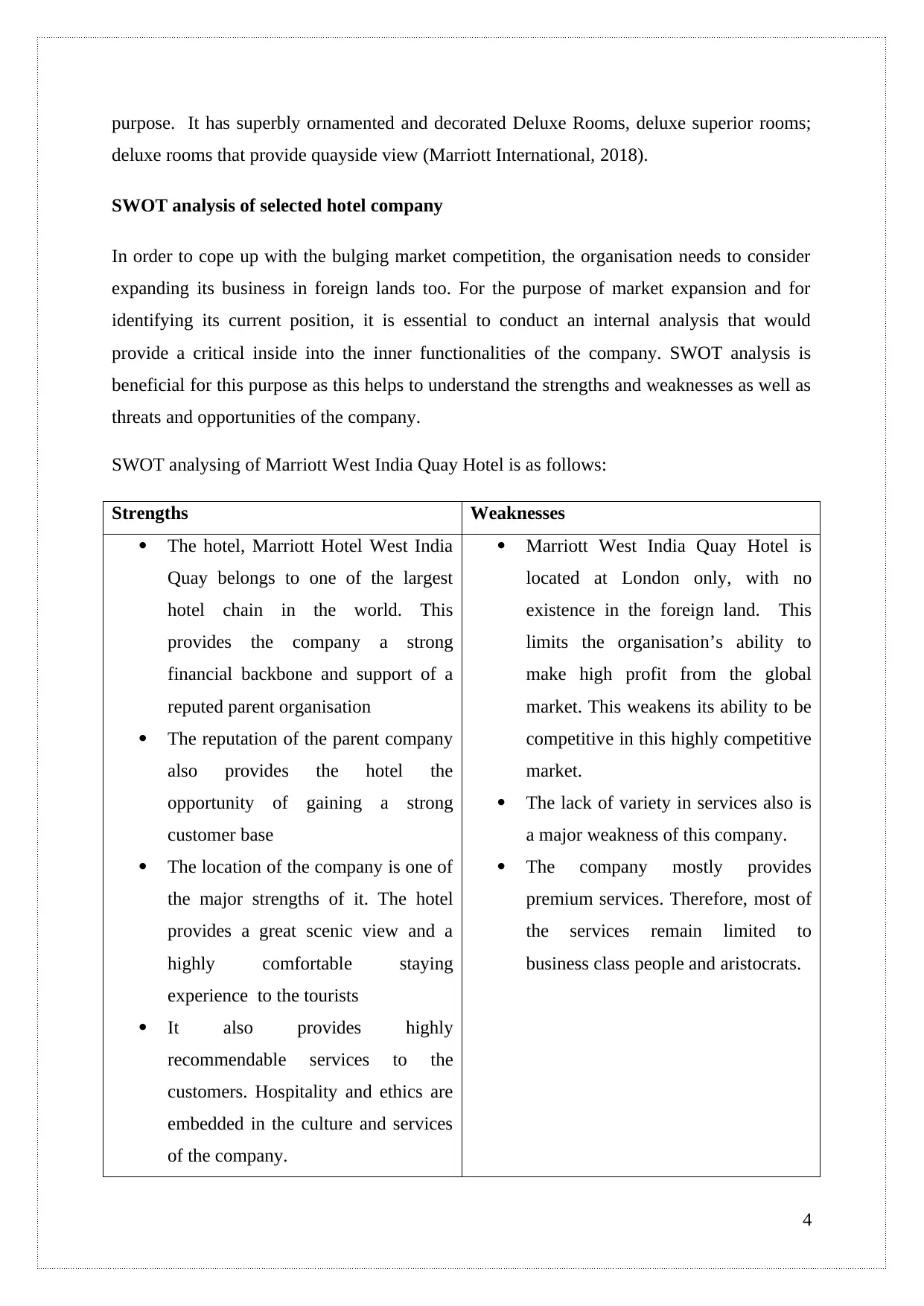
purpose. It has superbly ornamented and decorated Deluxe Rooms, deluxe superior rooms;
deluxe rooms that provide quayside view (Marriott International, 2018).
SWOT analysis of selected hotel company
In order to cope up with the bulging market competition, the organisation needs to consider
expanding its business in foreign lands too. For the purpose of market expansion and for
identifying its current position, it is essential to conduct an internal analysis that would
provide a critical inside into the inner functionalities of the company. SWOT analysis is
beneficial for this purpose as this helps to understand the strengths and weaknesses as well as
threats and opportunities of the company.
SWOT analysing of Marriott West India Quay Hotel is as follows:
Strengths Weaknesses
The hotel, Marriott Hotel West India
Quay belongs to one of the largest
hotel chain in the world. This
provides the company a strong
financial backbone and support of a
reputed parent organisation
The reputation of the parent company
also provides the hotel the
opportunity of gaining a strong
customer base
The location of the company is one of
the major strengths of it. The hotel
provides a great scenic view and a
highly comfortable staying
experience to the tourists
It also provides highly
recommendable services to the
customers. Hospitality and ethics are
embedded in the culture and services
of the company.
Marriott West India Quay Hotel is
located at London only, with no
existence in the foreign land. This
limits the organisation’s ability to
make high profit from the global
market. This weakens its ability to be
competitive in this highly competitive
market.
The lack of variety in services also is
a major weakness of this company.
The company mostly provides
premium services. Therefore, most of
the services remain limited to
business class people and aristocrats.
4
deluxe rooms that provide quayside view (Marriott International, 2018).
SWOT analysis of selected hotel company
In order to cope up with the bulging market competition, the organisation needs to consider
expanding its business in foreign lands too. For the purpose of market expansion and for
identifying its current position, it is essential to conduct an internal analysis that would
provide a critical inside into the inner functionalities of the company. SWOT analysis is
beneficial for this purpose as this helps to understand the strengths and weaknesses as well as
threats and opportunities of the company.
SWOT analysing of Marriott West India Quay Hotel is as follows:
Strengths Weaknesses
The hotel, Marriott Hotel West India
Quay belongs to one of the largest
hotel chain in the world. This
provides the company a strong
financial backbone and support of a
reputed parent organisation
The reputation of the parent company
also provides the hotel the
opportunity of gaining a strong
customer base
The location of the company is one of
the major strengths of it. The hotel
provides a great scenic view and a
highly comfortable staying
experience to the tourists
It also provides highly
recommendable services to the
customers. Hospitality and ethics are
embedded in the culture and services
of the company.
Marriott West India Quay Hotel is
located at London only, with no
existence in the foreign land. This
limits the organisation’s ability to
make high profit from the global
market. This weakens its ability to be
competitive in this highly competitive
market.
The lack of variety in services also is
a major weakness of this company.
The company mostly provides
premium services. Therefore, most of
the services remain limited to
business class people and aristocrats.
4
Paraphrase This Document
Need a fresh take? Get an instant paraphrase of this document with our AI Paraphraser
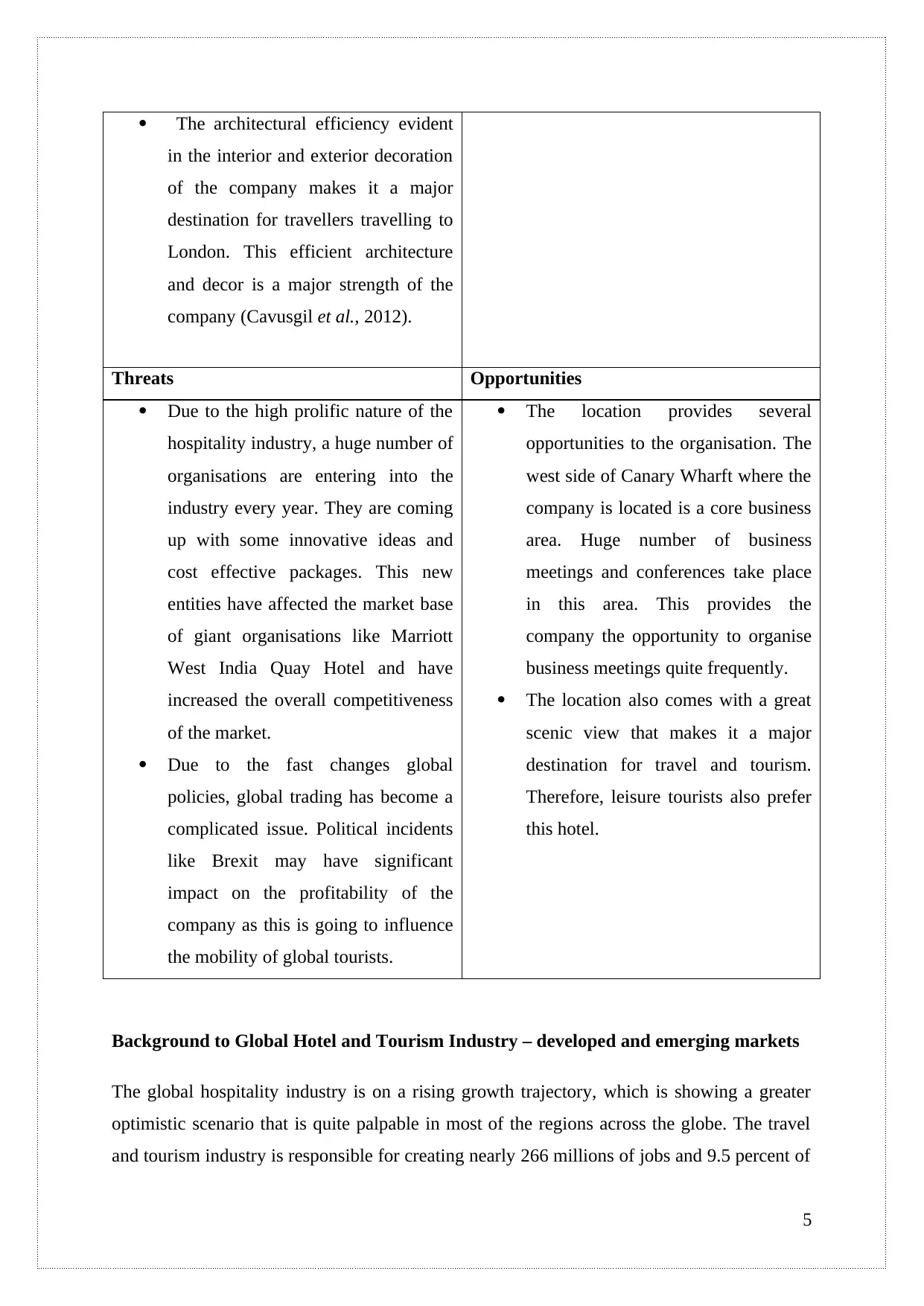
The architectural efficiency evident
in the interior and exterior decoration
of the company makes it a major
destination for travellers travelling to
London. This efficient architecture
and decor is a major strength of the
company (Cavusgil et al., 2012).
Threats Opportunities
Due to the high prolific nature of the
hospitality industry, a huge number of
organisations are entering into the
industry every year. They are coming
up with some innovative ideas and
cost effective packages. This new
entities have affected the market base
of giant organisations like Marriott
West India Quay Hotel and have
increased the overall competitiveness
of the market.
Due to the fast changes global
policies, global trading has become a
complicated issue. Political incidents
like Brexit may have significant
impact on the profitability of the
company as this is going to influence
the mobility of global tourists.
The location provides several
opportunities to the organisation. The
west side of Canary Wharft where the
company is located is a core business
area. Huge number of business
meetings and conferences take place
in this area. This provides the
company the opportunity to organise
business meetings quite frequently.
The location also comes with a great
scenic view that makes it a major
destination for travel and tourism.
Therefore, leisure tourists also prefer
this hotel.
Background to Global Hotel and Tourism Industry – developed and emerging markets
The global hospitality industry is on a rising growth trajectory, which is showing a greater
optimistic scenario that is quite palpable in most of the regions across the globe. The travel
and tourism industry is responsible for creating nearly 266 millions of jobs and 9.5 percent of
5
in the interior and exterior decoration
of the company makes it a major
destination for travellers travelling to
London. This efficient architecture
and decor is a major strength of the
company (Cavusgil et al., 2012).
Threats Opportunities
Due to the high prolific nature of the
hospitality industry, a huge number of
organisations are entering into the
industry every year. They are coming
up with some innovative ideas and
cost effective packages. This new
entities have affected the market base
of giant organisations like Marriott
West India Quay Hotel and have
increased the overall competitiveness
of the market.
Due to the fast changes global
policies, global trading has become a
complicated issue. Political incidents
like Brexit may have significant
impact on the profitability of the
company as this is going to influence
the mobility of global tourists.
The location provides several
opportunities to the organisation. The
west side of Canary Wharft where the
company is located is a core business
area. Huge number of business
meetings and conferences take place
in this area. This provides the
company the opportunity to organise
business meetings quite frequently.
The location also comes with a great
scenic view that makes it a major
destination for travel and tourism.
Therefore, leisure tourists also prefer
this hotel.
Background to Global Hotel and Tourism Industry – developed and emerging markets
The global hospitality industry is on a rising growth trajectory, which is showing a greater
optimistic scenario that is quite palpable in most of the regions across the globe. The travel
and tourism industry is responsible for creating nearly 266 millions of jobs and 9.5 percent of
5
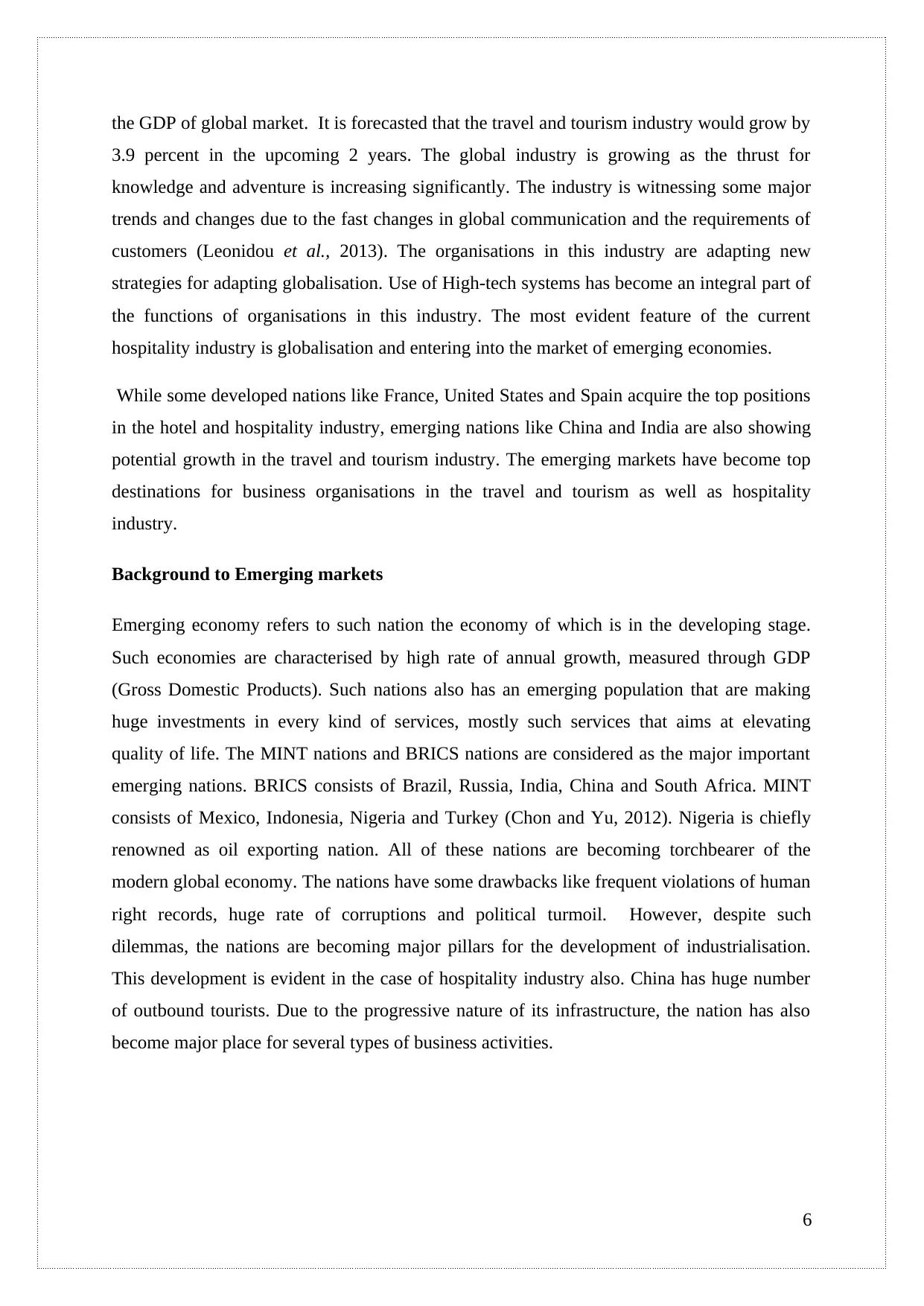
the GDP of global market. It is forecasted that the travel and tourism industry would grow by
3.9 percent in the upcoming 2 years. The global industry is growing as the thrust for
knowledge and adventure is increasing significantly. The industry is witnessing some major
trends and changes due to the fast changes in global communication and the requirements of
customers (Leonidou et al., 2013). The organisations in this industry are adapting new
strategies for adapting globalisation. Use of High-tech systems has become an integral part of
the functions of organisations in this industry. The most evident feature of the current
hospitality industry is globalisation and entering into the market of emerging economies.
While some developed nations like France, United States and Spain acquire the top positions
in the hotel and hospitality industry, emerging nations like China and India are also showing
potential growth in the travel and tourism industry. The emerging markets have become top
destinations for business organisations in the travel and tourism as well as hospitality
industry.
Background to Emerging markets
Emerging economy refers to such nation the economy of which is in the developing stage.
Such economies are characterised by high rate of annual growth, measured through GDP
(Gross Domestic Products). Such nations also has an emerging population that are making
huge investments in every kind of services, mostly such services that aims at elevating
quality of life. The MINT nations and BRICS nations are considered as the major important
emerging nations. BRICS consists of Brazil, Russia, India, China and South Africa. MINT
consists of Mexico, Indonesia, Nigeria and Turkey (Chon and Yu, 2012). Nigeria is chiefly
renowned as oil exporting nation. All of these nations are becoming torchbearer of the
modern global economy. The nations have some drawbacks like frequent violations of human
right records, huge rate of corruptions and political turmoil. However, despite such
dilemmas, the nations are becoming major pillars for the development of industrialisation.
This development is evident in the case of hospitality industry also. China has huge number
of outbound tourists. Due to the progressive nature of its infrastructure, the nation has also
become major place for several types of business activities.
6
3.9 percent in the upcoming 2 years. The global industry is growing as the thrust for
knowledge and adventure is increasing significantly. The industry is witnessing some major
trends and changes due to the fast changes in global communication and the requirements of
customers (Leonidou et al., 2013). The organisations in this industry are adapting new
strategies for adapting globalisation. Use of High-tech systems has become an integral part of
the functions of organisations in this industry. The most evident feature of the current
hospitality industry is globalisation and entering into the market of emerging economies.
While some developed nations like France, United States and Spain acquire the top positions
in the hotel and hospitality industry, emerging nations like China and India are also showing
potential growth in the travel and tourism industry. The emerging markets have become top
destinations for business organisations in the travel and tourism as well as hospitality
industry.
Background to Emerging markets
Emerging economy refers to such nation the economy of which is in the developing stage.
Such economies are characterised by high rate of annual growth, measured through GDP
(Gross Domestic Products). Such nations also has an emerging population that are making
huge investments in every kind of services, mostly such services that aims at elevating
quality of life. The MINT nations and BRICS nations are considered as the major important
emerging nations. BRICS consists of Brazil, Russia, India, China and South Africa. MINT
consists of Mexico, Indonesia, Nigeria and Turkey (Chon and Yu, 2012). Nigeria is chiefly
renowned as oil exporting nation. All of these nations are becoming torchbearer of the
modern global economy. The nations have some drawbacks like frequent violations of human
right records, huge rate of corruptions and political turmoil. However, despite such
dilemmas, the nations are becoming major pillars for the development of industrialisation.
This development is evident in the case of hospitality industry also. China has huge number
of outbound tourists. Due to the progressive nature of its infrastructure, the nation has also
become major place for several types of business activities.
6
⊘ This is a preview!⊘
Do you want full access?
Subscribe today to unlock all pages.

Trusted by 1+ million students worldwide
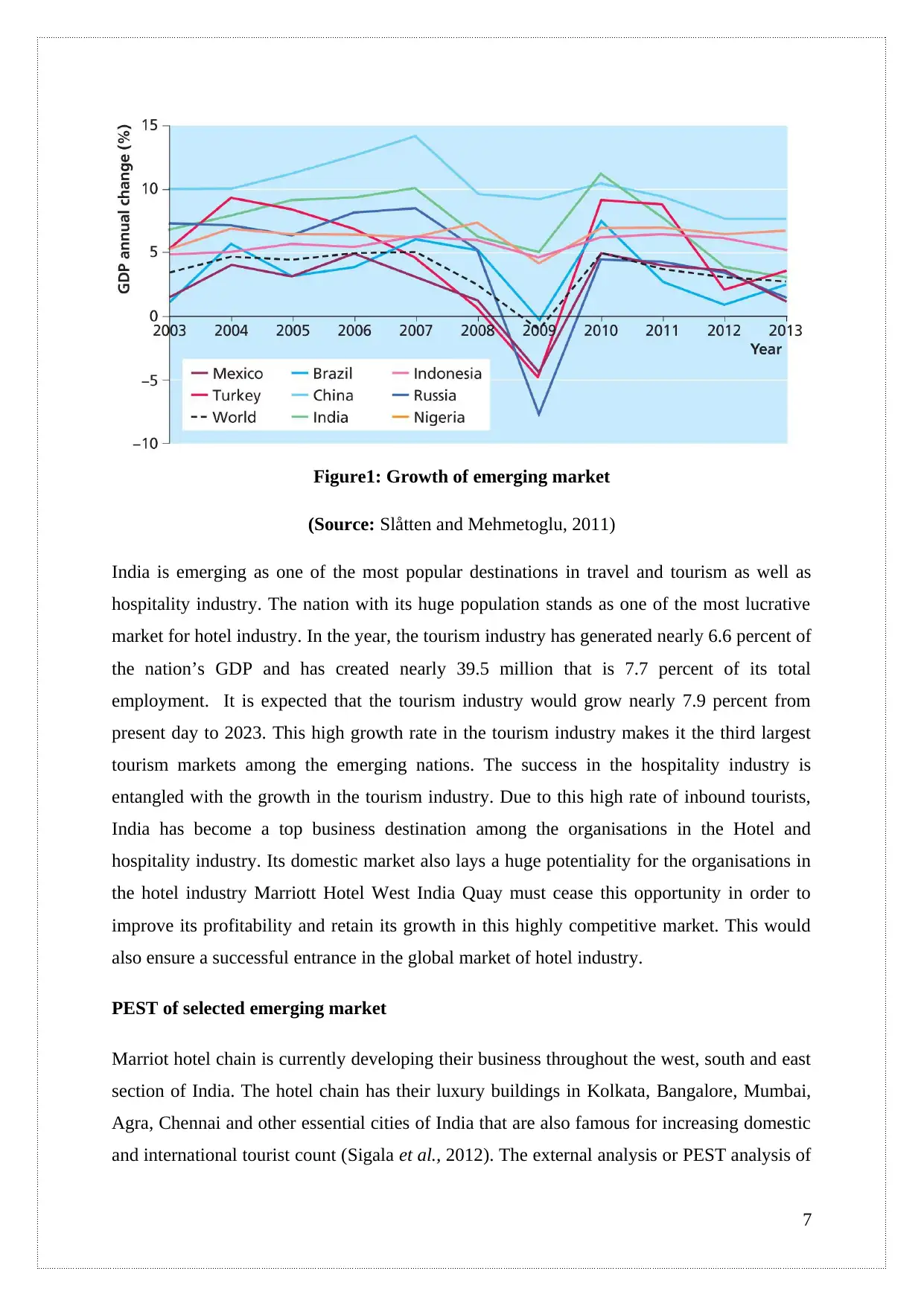
Figure1: Growth of emerging market
(Source: Slåtten and Mehmetoglu, 2011)
India is emerging as one of the most popular destinations in travel and tourism as well as
hospitality industry. The nation with its huge population stands as one of the most lucrative
market for hotel industry. In the year, the tourism industry has generated nearly 6.6 percent of
the nation’s GDP and has created nearly 39.5 million that is 7.7 percent of its total
employment. It is expected that the tourism industry would grow nearly 7.9 percent from
present day to 2023. This high growth rate in the tourism industry makes it the third largest
tourism markets among the emerging nations. The success in the hospitality industry is
entangled with the growth in the tourism industry. Due to this high rate of inbound tourists,
India has become a top business destination among the organisations in the Hotel and
hospitality industry. Its domestic market also lays a huge potentiality for the organisations in
the hotel industry Marriott Hotel West India Quay must cease this opportunity in order to
improve its profitability and retain its growth in this highly competitive market. This would
also ensure a successful entrance in the global market of hotel industry.
PEST of selected emerging market
Marriot hotel chain is currently developing their business throughout the west, south and east
section of India. The hotel chain has their luxury buildings in Kolkata, Bangalore, Mumbai,
Agra, Chennai and other essential cities of India that are also famous for increasing domestic
and international tourist count (Sigala et al., 2012). The external analysis or PEST analysis of
7
(Source: Slåtten and Mehmetoglu, 2011)
India is emerging as one of the most popular destinations in travel and tourism as well as
hospitality industry. The nation with its huge population stands as one of the most lucrative
market for hotel industry. In the year, the tourism industry has generated nearly 6.6 percent of
the nation’s GDP and has created nearly 39.5 million that is 7.7 percent of its total
employment. It is expected that the tourism industry would grow nearly 7.9 percent from
present day to 2023. This high growth rate in the tourism industry makes it the third largest
tourism markets among the emerging nations. The success in the hospitality industry is
entangled with the growth in the tourism industry. Due to this high rate of inbound tourists,
India has become a top business destination among the organisations in the Hotel and
hospitality industry. Its domestic market also lays a huge potentiality for the organisations in
the hotel industry Marriott Hotel West India Quay must cease this opportunity in order to
improve its profitability and retain its growth in this highly competitive market. This would
also ensure a successful entrance in the global market of hotel industry.
PEST of selected emerging market
Marriot hotel chain is currently developing their business throughout the west, south and east
section of India. The hotel chain has their luxury buildings in Kolkata, Bangalore, Mumbai,
Agra, Chennai and other essential cities of India that are also famous for increasing domestic
and international tourist count (Sigala et al., 2012). The external analysis or PEST analysis of
7
Paraphrase This Document
Need a fresh take? Get an instant paraphrase of this document with our AI Paraphraser

this emerging market includes various environmental regulators like Political, Economical,
Social, and Technological. The increasing growth of middle economy class people is
influencing the profit margin of the tourism and hospitality industry from their developing
lifestyle and lifestyle and individual expenditure.
Political
India has strong international political relationship with various
developed nations like USA, UK, Germany, Russia, Canada, and
others. From the beginning of cold war phase India has strategically
maintained the international relationship neutrally that adds extra
advantages in terms of global business connectivity as well as tourism
and hospitality (Buhalis and Crotts, 2013). On the other hand, the
Indian government always encourages their tourism and hospitality
industry to be involved in both domestic and international tourism. It
has a huge positive influence on the conventional tourism and
hospitality market of India as well as on international tourism and
hospitality industry. From the beginning of 2010 Indian government has
taken some initiatives to boost up their global tourism market and
external investment with various encouraging campaigns like “Atithi
Dava Vaba” and “Incredible India”.
Economical
The economical growth of India is significantly high from the past ten
years that has huge impact on global tourism and industry. The GDP
growth rate of India is very steady and increasing by 10% per year
(Sheth, 2011). The most dense and rapidly growing population has
influence the per capita income that has strong influence in lifestyle and
individual expenditure. This increasing population can boost the profit
margin by 10.11% depending on only domestic tourism. On the other
hand, the amount middle economy class people are growing
significantly influencing the profit margin of the tourism and hospitality
industry from luxury, adventure and health based tourism. International
tourists are spending around 8.9USD billion annually, which add
significant profit in national and international hospitality business in the
emerging market of India.
8
Social, and Technological. The increasing growth of middle economy class people is
influencing the profit margin of the tourism and hospitality industry from their developing
lifestyle and lifestyle and individual expenditure.
Political
India has strong international political relationship with various
developed nations like USA, UK, Germany, Russia, Canada, and
others. From the beginning of cold war phase India has strategically
maintained the international relationship neutrally that adds extra
advantages in terms of global business connectivity as well as tourism
and hospitality (Buhalis and Crotts, 2013). On the other hand, the
Indian government always encourages their tourism and hospitality
industry to be involved in both domestic and international tourism. It
has a huge positive influence on the conventional tourism and
hospitality market of India as well as on international tourism and
hospitality industry. From the beginning of 2010 Indian government has
taken some initiatives to boost up their global tourism market and
external investment with various encouraging campaigns like “Atithi
Dava Vaba” and “Incredible India”.
Economical
The economical growth of India is significantly high from the past ten
years that has huge impact on global tourism and industry. The GDP
growth rate of India is very steady and increasing by 10% per year
(Sheth, 2011). The most dense and rapidly growing population has
influence the per capita income that has strong influence in lifestyle and
individual expenditure. This increasing population can boost the profit
margin by 10.11% depending on only domestic tourism. On the other
hand, the amount middle economy class people are growing
significantly influencing the profit margin of the tourism and hospitality
industry from luxury, adventure and health based tourism. International
tourists are spending around 8.9USD billion annually, which add
significant profit in national and international hospitality business in the
emerging market of India.
8
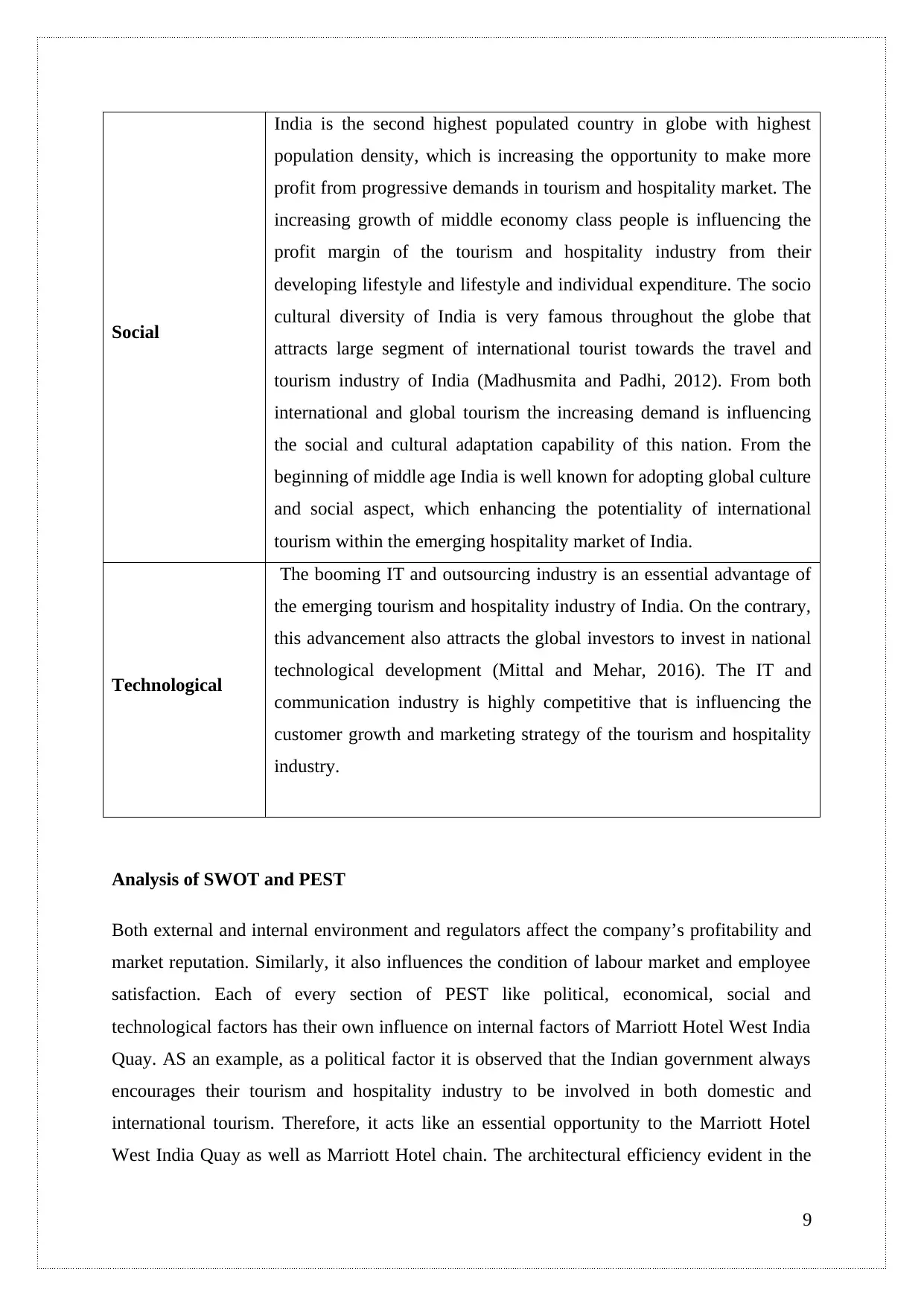
Social
India is the second highest populated country in globe with highest
population density, which is increasing the opportunity to make more
profit from progressive demands in tourism and hospitality market. The
increasing growth of middle economy class people is influencing the
profit margin of the tourism and hospitality industry from their
developing lifestyle and lifestyle and individual expenditure. The socio
cultural diversity of India is very famous throughout the globe that
attracts large segment of international tourist towards the travel and
tourism industry of India (Madhusmita and Padhi, 2012). From both
international and global tourism the increasing demand is influencing
the social and cultural adaptation capability of this nation. From the
beginning of middle age India is well known for adopting global culture
and social aspect, which enhancing the potentiality of international
tourism within the emerging hospitality market of India.
Technological
The booming IT and outsourcing industry is an essential advantage of
the emerging tourism and hospitality industry of India. On the contrary,
this advancement also attracts the global investors to invest in national
technological development (Mittal and Mehar, 2016). The IT and
communication industry is highly competitive that is influencing the
customer growth and marketing strategy of the tourism and hospitality
industry.
Analysis of SWOT and PEST
Both external and internal environment and regulators affect the company’s profitability and
market reputation. Similarly, it also influences the condition of labour market and employee
satisfaction. Each of every section of PEST like political, economical, social and
technological factors has their own influence on internal factors of Marriott Hotel West India
Quay. AS an example, as a political factor it is observed that the Indian government always
encourages their tourism and hospitality industry to be involved in both domestic and
international tourism. Therefore, it acts like an essential opportunity to the Marriott Hotel
West India Quay as well as Marriott Hotel chain. The architectural efficiency evident in the
9
India is the second highest populated country in globe with highest
population density, which is increasing the opportunity to make more
profit from progressive demands in tourism and hospitality market. The
increasing growth of middle economy class people is influencing the
profit margin of the tourism and hospitality industry from their
developing lifestyle and lifestyle and individual expenditure. The socio
cultural diversity of India is very famous throughout the globe that
attracts large segment of international tourist towards the travel and
tourism industry of India (Madhusmita and Padhi, 2012). From both
international and global tourism the increasing demand is influencing
the social and cultural adaptation capability of this nation. From the
beginning of middle age India is well known for adopting global culture
and social aspect, which enhancing the potentiality of international
tourism within the emerging hospitality market of India.
Technological
The booming IT and outsourcing industry is an essential advantage of
the emerging tourism and hospitality industry of India. On the contrary,
this advancement also attracts the global investors to invest in national
technological development (Mittal and Mehar, 2016). The IT and
communication industry is highly competitive that is influencing the
customer growth and marketing strategy of the tourism and hospitality
industry.
Analysis of SWOT and PEST
Both external and internal environment and regulators affect the company’s profitability and
market reputation. Similarly, it also influences the condition of labour market and employee
satisfaction. Each of every section of PEST like political, economical, social and
technological factors has their own influence on internal factors of Marriott Hotel West India
Quay. AS an example, as a political factor it is observed that the Indian government always
encourages their tourism and hospitality industry to be involved in both domestic and
international tourism. Therefore, it acts like an essential opportunity to the Marriott Hotel
West India Quay as well as Marriott Hotel chain. The architectural efficiency evident in the
9
⊘ This is a preview!⊘
Do you want full access?
Subscribe today to unlock all pages.

Trusted by 1+ million students worldwide
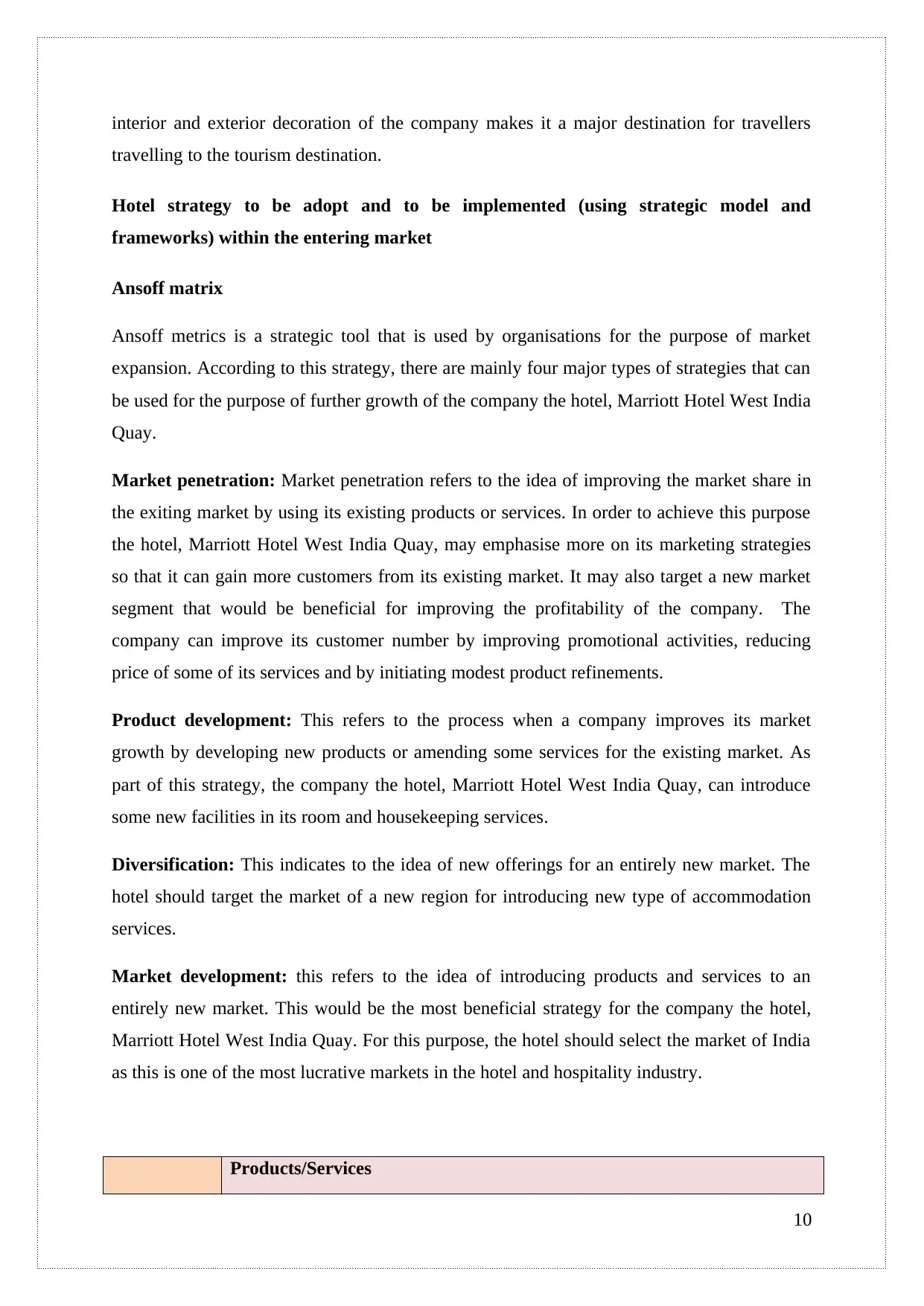
interior and exterior decoration of the company makes it a major destination for travellers
travelling to the tourism destination.
Hotel strategy to be adopt and to be implemented (using strategic model and
frameworks) within the entering market
Ansoff matrix
Ansoff metrics is a strategic tool that is used by organisations for the purpose of market
expansion. According to this strategy, there are mainly four major types of strategies that can
be used for the purpose of further growth of the company the hotel, Marriott Hotel West India
Quay.
Market penetration: Market penetration refers to the idea of improving the market share in
the exiting market by using its existing products or services. In order to achieve this purpose
the hotel, Marriott Hotel West India Quay, may emphasise more on its marketing strategies
so that it can gain more customers from its existing market. It may also target a new market
segment that would be beneficial for improving the profitability of the company. The
company can improve its customer number by improving promotional activities, reducing
price of some of its services and by initiating modest product refinements.
Product development: This refers to the process when a company improves its market
growth by developing new products or amending some services for the existing market. As
part of this strategy, the company the hotel, Marriott Hotel West India Quay, can introduce
some new facilities in its room and housekeeping services.
Diversification: This indicates to the idea of new offerings for an entirely new market. The
hotel should target the market of a new region for introducing new type of accommodation
services.
Market development: this refers to the idea of introducing products and services to an
entirely new market. This would be the most beneficial strategy for the company the hotel,
Marriott Hotel West India Quay. For this purpose, the hotel should select the market of India
as this is one of the most lucrative markets in the hotel and hospitality industry.
Products/Services
10
travelling to the tourism destination.
Hotel strategy to be adopt and to be implemented (using strategic model and
frameworks) within the entering market
Ansoff matrix
Ansoff metrics is a strategic tool that is used by organisations for the purpose of market
expansion. According to this strategy, there are mainly four major types of strategies that can
be used for the purpose of further growth of the company the hotel, Marriott Hotel West India
Quay.
Market penetration: Market penetration refers to the idea of improving the market share in
the exiting market by using its existing products or services. In order to achieve this purpose
the hotel, Marriott Hotel West India Quay, may emphasise more on its marketing strategies
so that it can gain more customers from its existing market. It may also target a new market
segment that would be beneficial for improving the profitability of the company. The
company can improve its customer number by improving promotional activities, reducing
price of some of its services and by initiating modest product refinements.
Product development: This refers to the process when a company improves its market
growth by developing new products or amending some services for the existing market. As
part of this strategy, the company the hotel, Marriott Hotel West India Quay, can introduce
some new facilities in its room and housekeeping services.
Diversification: This indicates to the idea of new offerings for an entirely new market. The
hotel should target the market of a new region for introducing new type of accommodation
services.
Market development: this refers to the idea of introducing products and services to an
entirely new market. This would be the most beneficial strategy for the company the hotel,
Marriott Hotel West India Quay. For this purpose, the hotel should select the market of India
as this is one of the most lucrative markets in the hotel and hospitality industry.
Products/Services
10
Paraphrase This Document
Need a fresh take? Get an instant paraphrase of this document with our AI Paraphraser
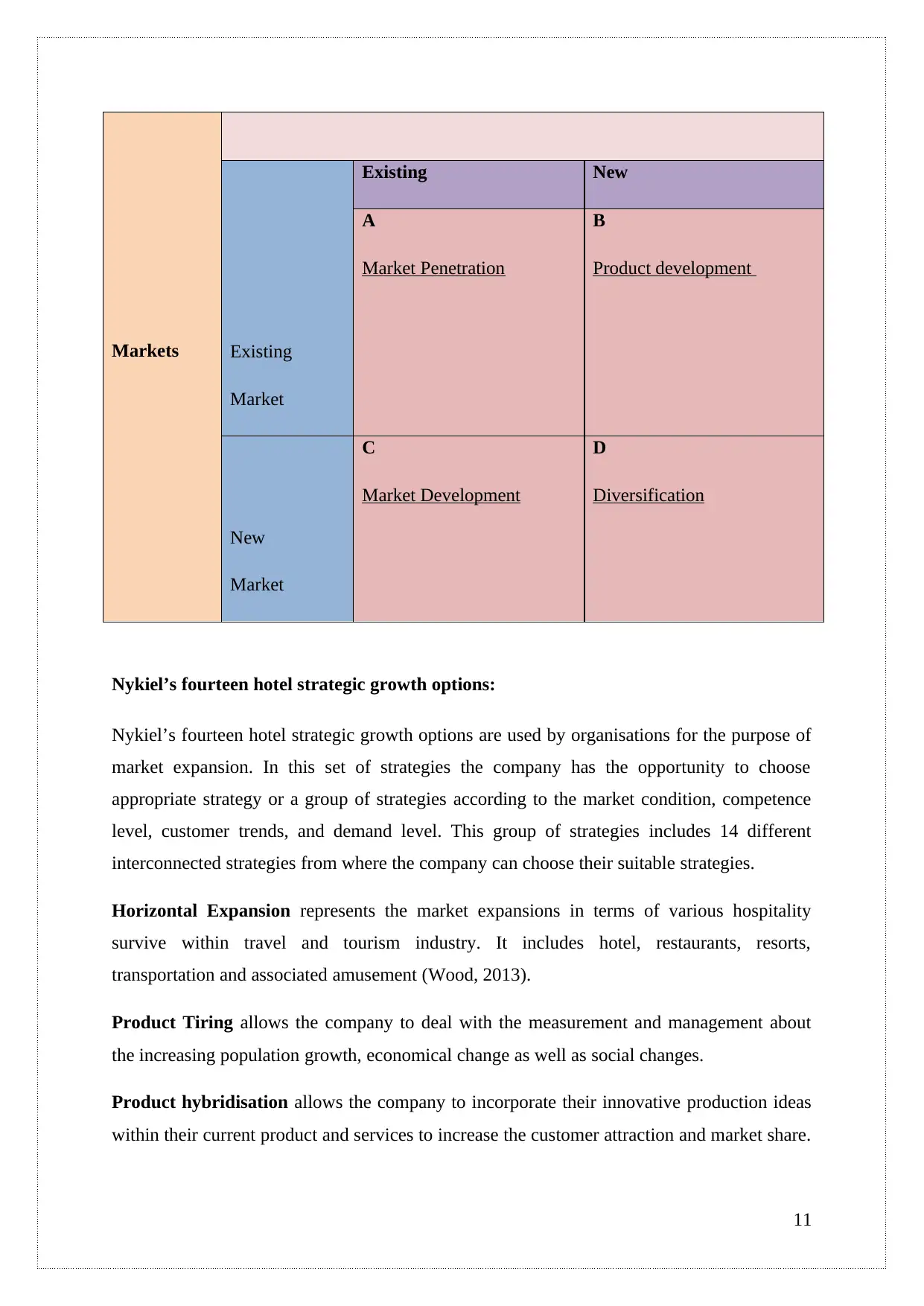
Markets Existing
Market
Existing New
A
Market Penetration
B
Product development
New
Market
C
Market Development
D
Diversification
Nykiel’s fourteen hotel strategic growth options:
Nykiel’s fourteen hotel strategic growth options are used by organisations for the purpose of
market expansion. In this set of strategies the company has the opportunity to choose
appropriate strategy or a group of strategies according to the market condition, competence
level, customer trends, and demand level. This group of strategies includes 14 different
interconnected strategies from where the company can choose their suitable strategies.
Horizontal Expansion represents the market expansions in terms of various hospitality
survive within travel and tourism industry. It includes hotel, restaurants, resorts,
transportation and associated amusement (Wood, 2013).
Product Tiring allows the company to deal with the measurement and management about
the increasing population growth, economical change as well as social changes.
Product hybridisation allows the company to incorporate their innovative production ideas
within their current product and services to increase the customer attraction and market share.
11
Market
Existing New
A
Market Penetration
B
Product development
New
Market
C
Market Development
D
Diversification
Nykiel’s fourteen hotel strategic growth options:
Nykiel’s fourteen hotel strategic growth options are used by organisations for the purpose of
market expansion. In this set of strategies the company has the opportunity to choose
appropriate strategy or a group of strategies according to the market condition, competence
level, customer trends, and demand level. This group of strategies includes 14 different
interconnected strategies from where the company can choose their suitable strategies.
Horizontal Expansion represents the market expansions in terms of various hospitality
survive within travel and tourism industry. It includes hotel, restaurants, resorts,
transportation and associated amusement (Wood, 2013).
Product Tiring allows the company to deal with the measurement and management about
the increasing population growth, economical change as well as social changes.
Product hybridisation allows the company to incorporate their innovative production ideas
within their current product and services to increase the customer attraction and market share.
11
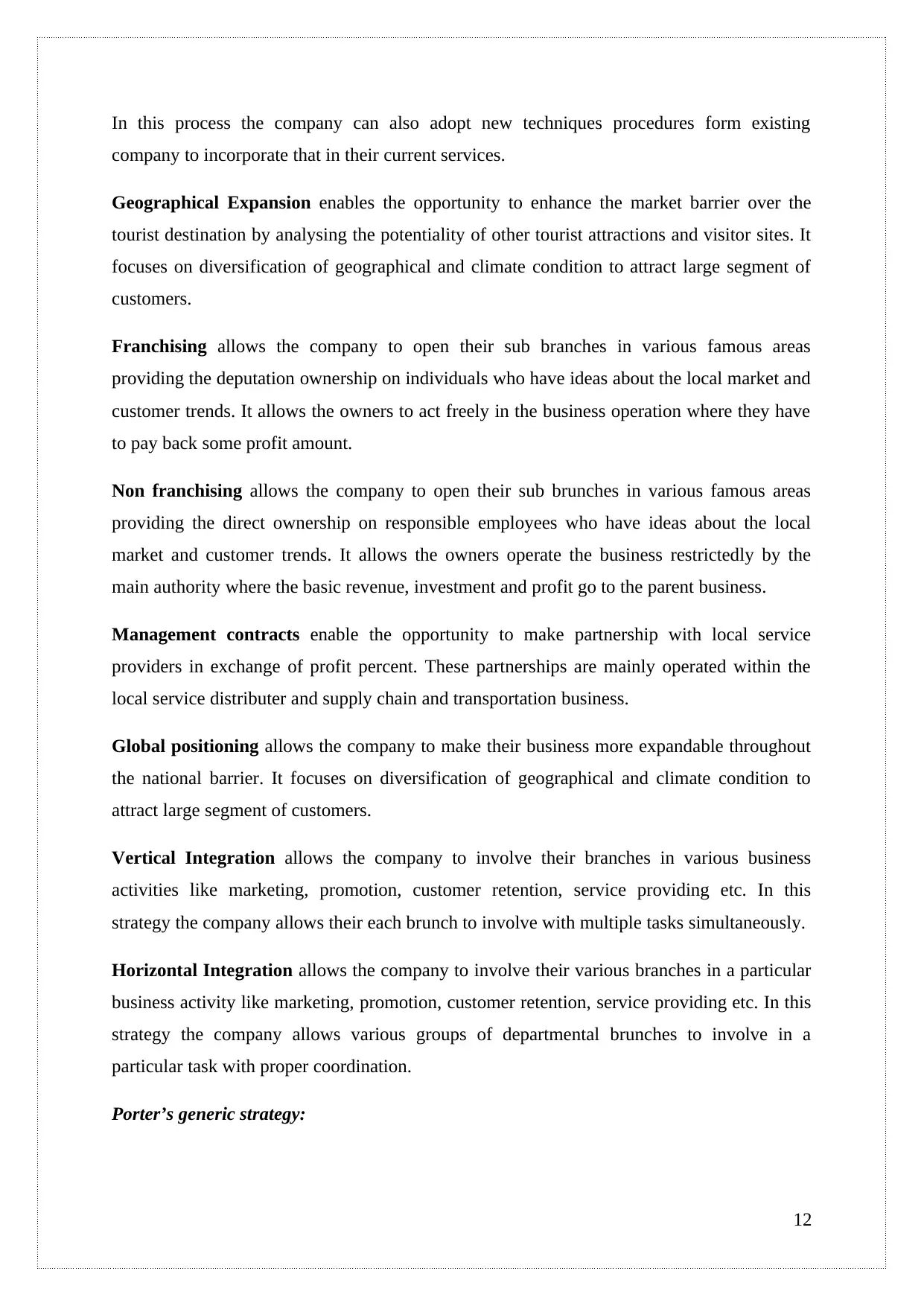
In this process the company can also adopt new techniques procedures form existing
company to incorporate that in their current services.
Geographical Expansion enables the opportunity to enhance the market barrier over the
tourist destination by analysing the potentiality of other tourist attractions and visitor sites. It
focuses on diversification of geographical and climate condition to attract large segment of
customers.
Franchising allows the company to open their sub branches in various famous areas
providing the deputation ownership on individuals who have ideas about the local market and
customer trends. It allows the owners to act freely in the business operation where they have
to pay back some profit amount.
Non franchising allows the company to open their sub brunches in various famous areas
providing the direct ownership on responsible employees who have ideas about the local
market and customer trends. It allows the owners operate the business restrictedly by the
main authority where the basic revenue, investment and profit go to the parent business.
Management contracts enable the opportunity to make partnership with local service
providers in exchange of profit percent. These partnerships are mainly operated within the
local service distributer and supply chain and transportation business.
Global positioning allows the company to make their business more expandable throughout
the national barrier. It focuses on diversification of geographical and climate condition to
attract large segment of customers.
Vertical Integration allows the company to involve their branches in various business
activities like marketing, promotion, customer retention, service providing etc. In this
strategy the company allows their each brunch to involve with multiple tasks simultaneously.
Horizontal Integration allows the company to involve their various branches in a particular
business activity like marketing, promotion, customer retention, service providing etc. In this
strategy the company allows various groups of departmental brunches to involve in a
particular task with proper coordination.
Porter’s generic strategy:
12
company to incorporate that in their current services.
Geographical Expansion enables the opportunity to enhance the market barrier over the
tourist destination by analysing the potentiality of other tourist attractions and visitor sites. It
focuses on diversification of geographical and climate condition to attract large segment of
customers.
Franchising allows the company to open their sub branches in various famous areas
providing the deputation ownership on individuals who have ideas about the local market and
customer trends. It allows the owners to act freely in the business operation where they have
to pay back some profit amount.
Non franchising allows the company to open their sub brunches in various famous areas
providing the direct ownership on responsible employees who have ideas about the local
market and customer trends. It allows the owners operate the business restrictedly by the
main authority where the basic revenue, investment and profit go to the parent business.
Management contracts enable the opportunity to make partnership with local service
providers in exchange of profit percent. These partnerships are mainly operated within the
local service distributer and supply chain and transportation business.
Global positioning allows the company to make their business more expandable throughout
the national barrier. It focuses on diversification of geographical and climate condition to
attract large segment of customers.
Vertical Integration allows the company to involve their branches in various business
activities like marketing, promotion, customer retention, service providing etc. In this
strategy the company allows their each brunch to involve with multiple tasks simultaneously.
Horizontal Integration allows the company to involve their various branches in a particular
business activity like marketing, promotion, customer retention, service providing etc. In this
strategy the company allows various groups of departmental brunches to involve in a
particular task with proper coordination.
Porter’s generic strategy:
12
⊘ This is a preview!⊘
Do you want full access?
Subscribe today to unlock all pages.

Trusted by 1+ million students worldwide
1 out of 20
Related Documents
Your All-in-One AI-Powered Toolkit for Academic Success.
+13062052269
info@desklib.com
Available 24*7 on WhatsApp / Email
![[object Object]](/_next/static/media/star-bottom.7253800d.svg)
Unlock your academic potential
Copyright © 2020–2026 A2Z Services. All Rights Reserved. Developed and managed by ZUCOL.





